公开征求《安全生产行政处罚裁量权基准(征求意见稿)》意见!
Source: Yongkang Zhongyi Manufacture & Trade Co., Ltd.Publication time:2023-10-18
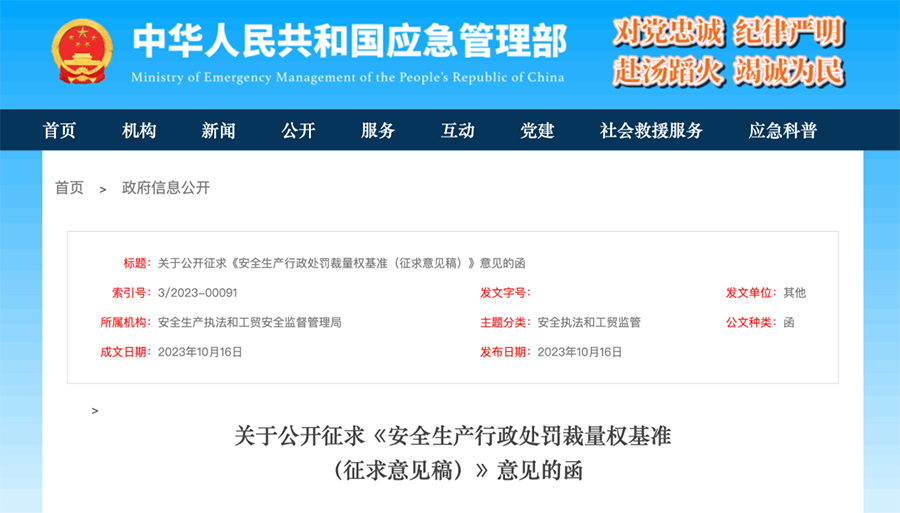
Letter on Publicly Soliciting Opinions on the "Standards for Discretionary Power of Administrative Penalties in Safety Production (Draft for Soliciting Opinions)"
In order to establish and improve the benchmark system of administrative discretion, standardize the exercise of administrative penalty discretion for safety production, and protect the legitimate rights and interests of citizens, legal persons, and other organizations, our department has drafted the "Standard for Administrative Penalty Discretionary Power for Safety Production (Draft for Soliciting Opinions)", which is now open to the public for opinions. The deadline for feedback is November 15, 2023. Please send feedback to your email address aqscfzjs@163.com .
Contact person and phone number: Chen Yu, 010-84657872.
Attachment:
1. Standards for Discretionary Power of Administrative Penalties in Safety Production (Draft for Soliciting Opinions)
2. Drafting instructions for the discretionary power benchmark of administrative penalties for safety production (draft for soliciting opinions)
Emergency Management Department Safety Law Enforcement and Industry and Trade Supervision Bureau
October 16, 2023
Attachment 1:
Benchmark for Discretionary Power of Administrative Penalties in Safety Production (Draft for Soliciting Opinions)

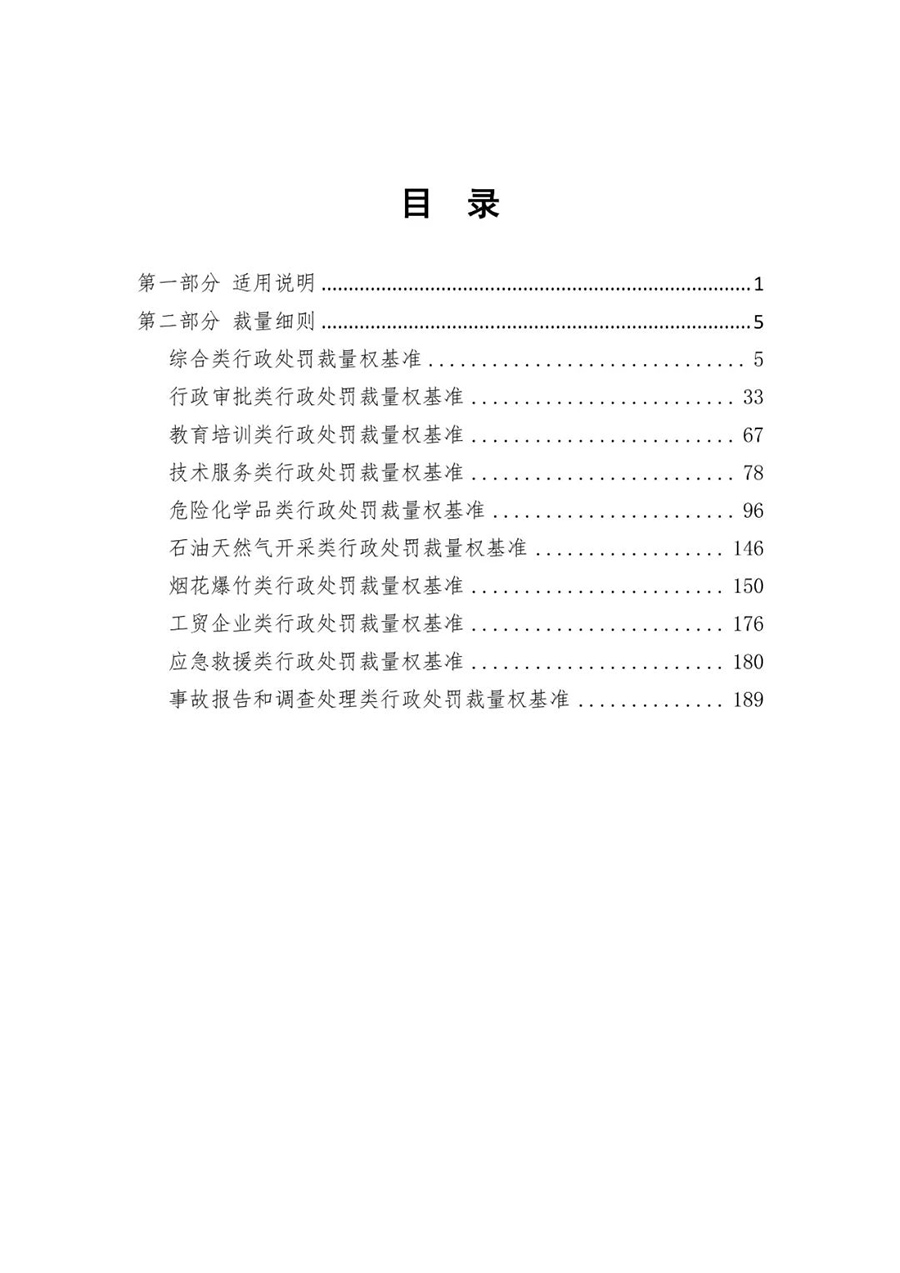
Attachment 2
Drafting Explanation of the "Standards for Discretionary Power of Administrative Penalties in Safety Production (Draft for Soliciting Opinions)"
In order to correctly apply the newly revised and promulgated safety production laws, administrative regulations, and departmental rules, standardize the exercise of administrative penalty discretion by emergency management departments, better protect the legitimate rights and interests of market entities and the people, and achieve lawful administration and fair law enforcement, the Safety Production Law Enforcement and Industry and Trade Safety Supervision Administration of the Emergency Management Department has drafted the "Safety Production Administrative Penalty Discretionary Power Benchmark" (hereinafter referred to as the "Benchmark"). The relevant situation is explained as follows.
1、 Research background
The benchmark of administrative penalty discretion for safety production is an important guide to guide and standardize the correct exercise of administrative penalty discretion by emergency management departments, further standardize safety production law enforcement behavior, and effectively promote legal administrative work. The "Discretionary Standards for Administrative Penalties on Work Safety" formulated by the former State Administration of Work Safety in 2010 has a relatively long history and overall content is relatively outdated. Although some regions have established relevant standards for the discretion of administrative penalties on work safety, the scale of discretion is inconsistent, leading to problems such as "different punishments for different cases" in practice. Since the 18th National Congress of the Communist Party of China, with the comprehensive promotion of governing the country by law, strengthening governance by law, using governance thinking and legal means to solve safety production problems, a series of laws and regulations related to safety production have been formulated and revised, especially the revision of the Administrative Penalty Law and Safety Production Law in 2021, which has accelerated the pace of legal construction for safety production. Therefore, it is also necessary to accelerate the improvement of the benchmark system for administrative penalty discretion. In 2014, the Decision of the Central Committee of the Communist Party of China on Several Major Issues Concerning the Comprehensive Promotion of Rule of Law proposed the establishment and improvement of a benchmark system for administrative discretion, the refinement and quantification of administrative discretion standards, and the standardization of the scope, types, and extent of discretion. In 2019, the Decision of the Central Committee of the Communist Party of China on Several Major Issues Concerning Adhering to and Improving the Socialist System with Chinese Characteristics, Promoting the Modernization of the National Governance System and Governance Capacity emphasized the need to strictly regulate fair and civilized law enforcement, and regulate the discretion of law enforcement. In 2022, the "Opinions of the General Office of the State Council on Further Standardizing the Formulation and Management of Administrative Discretionary Power Benchmarks" further clarified the need to attach great importance to the formulation and management of administrative discretionary power benchmarks, strictly follow legal procedures to scientifically and reasonably formulate administrative discretionary power benchmarks for various departments and systems, and refine relevant work and put forward more requirements. In order to implement the decisions and deployments of the Central Committee of the Communist Party of China and the State Council, better apply the revision of laws and regulations such as the Safety Production Law, ensure the effective implementation of laws and regulations, further standardize administrative law enforcement actions for safety production, and maintain social fairness and justice, this "benchmark" is studied and formulated.
2、 Research process
(1) Collect data and coordinate the progress
Collect the "Administrative Penalty Discretionary Standards for Work Safety" formulated by provinces such as Beijing, Shandong, Hunan, and Jiangsu, and clarify the principles and basic framework for the formulation of the "Standards" in accordance with the relevant requirements of the "Opinions of the General Office of the State Council on Further Standardizing the Formulation and Management of Administrative Discretionary Standards".
(2) System sorting and sorting
Sort out 36 laws, administrative regulations, and departmental rules related to administrative penalties for safety production, organize the corresponding penalty provisions for safety production violations in each law, regulation, and regulation, and compile a table in the format of illegal behavior, legal provisions, penalty basis, discretion level, applicable conditions, and specific standards. On this basis, classify according to different types of illegal acts, and reorganize the administrative penalty discretion standards to form the "Standards" (first draft).
(3) Concentrated discussion and connected argumentation
During the preparation process of the "Benchmark", relevant experts were organized to conduct centralized discussions and revisions in Jiangsu from May 22nd to May 25th, and modifications and improvements were made based on the "Benchmark" (first draft). In addition, we will adopt the opinions of relevant experts and connect them with the "Guiding Catalogue for Comprehensive Administrative Law Enforcement Matters in Emergency Management (2023 Edition)" (Emergency [2023] No. 70) issued by the Emergency Management Department.
(4) Soliciting opinions, modifying and improving
A total of 27 opinions were solicited from the Personnel Department, Rescue Coordination Bureau, Hazardous Chemical Supervision Department 1, Hazardous Chemical Supervision Department 2, Policy and Regulations Department, Planning and Finance Department, and Investigation and Statistics Department, of which 20 were adopted and 7 were not adopted. The unaccepted opinions involve suggestions to add relevant content to the "Implementation Measures for Safety Production Licenses of Non Coal Mining Enterprises" and to delete two parts of the discretion rules for "uninsured safety production liability insurance". At the same time, preliminary suggestions have been sought from local emergency management departments. On the basis of studying the above opinions and suggestions one by one, after repeated revisions and improvements, the current "benchmark" (draft for soliciting opinions) has been formed.
3、 Basic principles
(1) Principle of legality
The formulation of administrative penalty discretion standards must be based on laws, administrative regulations, and departmental rules. The determination of discretion levels, levels, and specific standards must comply with the legislative intent. In terms of legal application, the principle of superior law over subordinate law, special law over ordinary law, and new law over old law is followed. Strictly limit the punishment types and discretion space set by the Administrative Penalty Law, Safety Production Law, and relevant laws and regulations.
(2) Rationality principle
The setting of the benchmark for administrative penalty discretion needs to consider the rationality of setting the level of discretion, while also taking into account the moderate flexibility of each level of discretion. We should consider both legal and factual factors comprehensively to avoid law enforcement personnel relying heavily on punishment for illegal behaviors with similar behaviors and similar harmful consequences.
(3) Proportionality principle
In the process of administrative penalty discretion, it is necessary to balance the realization of administrative law enforcement purposes and the protection of the rights and interests of the opposite party. On the premise of leveraging the initiative and flexibility of administrative agencies and their staff, the adverse effects should be limited to the smallest possible range and limit, achieving equal punishment.
(4) The principle of fairness, impartiality, and openness
For similar types of illegal acts with similar factors such as illegal facts, illegal nature, and illegal circumstances, the same legal basis and discretion should be applied as much as possible. The law enforcement procedures and judgment results should comply with the requirements of administrative law enforcement fairness and justice. At the same time, the basis, procedures, and benchmarks for administrative penalty discretion shall be announced within the legal framework, and the principle of fairness, impartiality, and openness shall be strictly adhered to.
4、 Research content
(1) Regulatory framework
Mainly studying a total of 36 effective laws, administrative regulations, and departmental rules related to administrative penalties for safety production in the current field of safety production. Please refer to the table below for details:

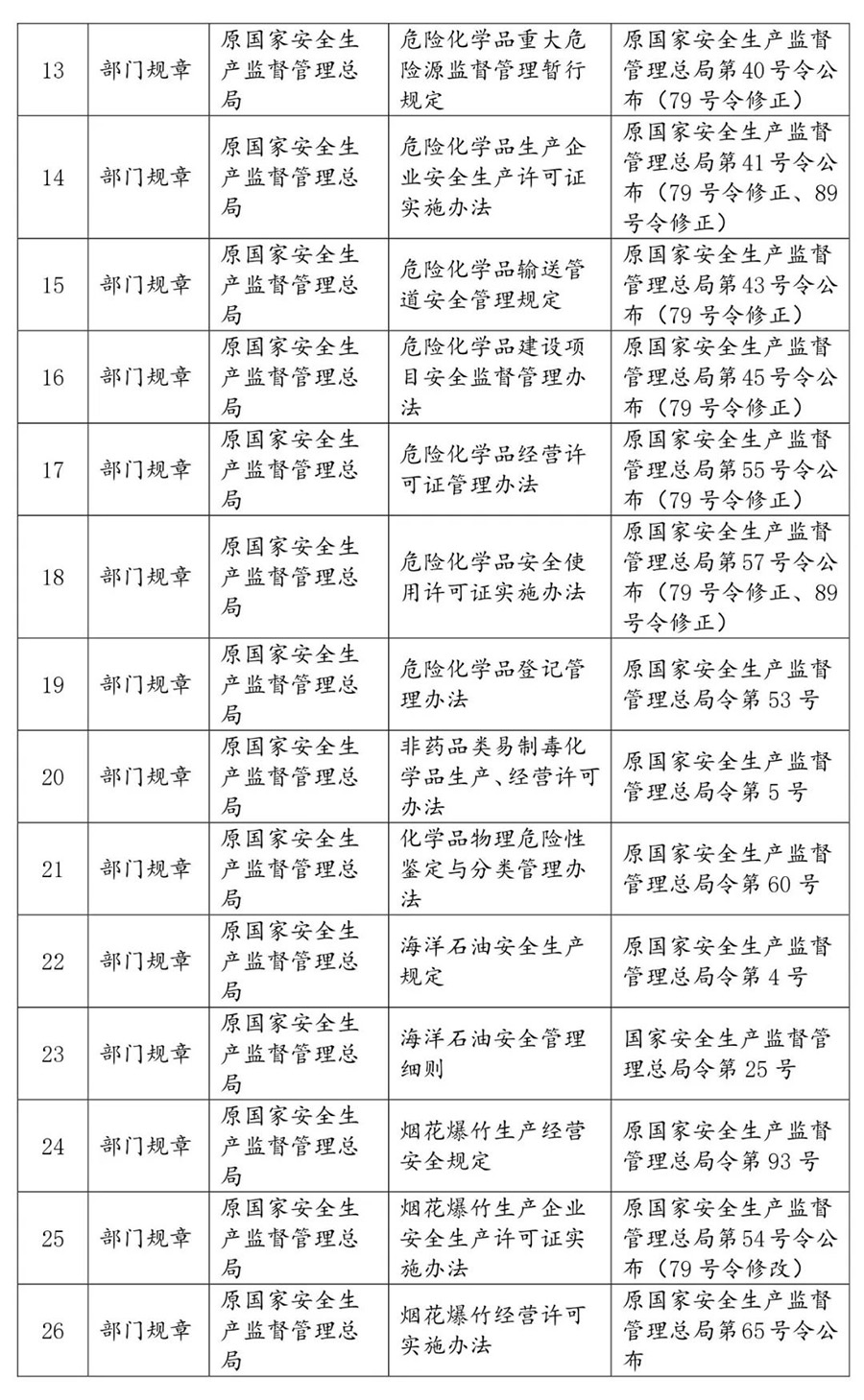

(2) Discretionary Rules Framework
1. Article structure. The discretion rules are divided into six parts, namely illegal acts, legal provisions, punishment basis, discretion order, applicable conditions, and specific standards. The basis for illegal acts, legal provisions, and penalties mainly refers to the original provisions of the law. According to the specific content of the law, illegal acts are classified according to different standards, and the order of discretion, applicable conditions, and specific standards are determined. The specific format is as follows:

2. Term of the clause. The laws and regulations involved do not specify whether "above" and "below" include this number. For the convenience of practical application, referring to other relevant laws and regulations, the "benchmark" clearly states that "above" includes this number, and "below" does not include this number except for the natural inclusion of this number and the highest grade "below" including this number as stipulated by law.
(3) Specific content
1. Illegal behavior. Mainly citing legal provisions, the content of the citation is specific to articles, paragraphs, and items, and one paragraph or item is an illegal act.
2. Legal provisions. Mainly citing legal provisions, citing obligations and prohibitions corresponding to illegal acts in laws, administrative regulations, and departmental rules.
3. Basis of punishment. Mainly citing legal provisions, if laws, administrative regulations, and departmental rules provide for the same illegal act, they shall be listed in order of effectiveness.
4. Discretionary order. The benchmark system of administrative penalty discretion mainly follows the principles of legality, rationality, proportionality, and fairness, impartiality, and openness. The establishment of administrative penalty discretion benchmarks combines legislative purposes, legal basis, types of punishment, and punishment amplitude, taking into account factors such as illegal facts, nature, means, circumstances, consequences, and corrective measures. The specific provisions are subject to grading principles for discretion, and the amount of fines is refined. Various types of illegal activities are classified as A, B, C, D, etc. based on their social harmfulness and severity of the situation, from low to high Wait for different levels of basic discretion.
5. Applicable conditions and specific standards. According to the Administrative Penalty Law and the Opinions of the State Council Office on Further Standardizing the Formulation and Management of Administrative Discretionary Power Benchmarks (Guo Ban Fa [2022] No. 27), the discretionary power of administrative penalties for safety production shall be archived and discretionary. The specific applicable conditions include: amount of illegal income, number of illegal acts, number of illegal items, project investment amount, number and scale of employers, duration of illegal acts, accidents, and severity of illegal acts. The specific standards are only set for fines in the types of administrative penalties, with a penalty amount of 10000 yuan or more. For illegal activities with a penalty amount of less than 10000 yuan or those that are difficult to determine the level of discretion, in order to ensure the space for law enforcement operations, no discretionary power benchmark is set. For fines with a maximum amount of more than 10000 yuan but less than 50000 yuan, the discretion level is generally between 10000 and 20000 yuan; If the maximum amount is greater than 50000 yuan but less than 100000 yuan, the discretion level is generally between 20000 and 40000 yuan; If the maximum amount is greater than 100000 yuan but less than 500000 yuan, the discretion level is generally between 50000 and 200000 yuan; For a maximum amount greater than 500000 yuan, the discretion level is generally between 200000 and 300000 yuan. The following examples illustrate:
(1) Illegal income standards. For example, Article 103 (1) of the Work Safety Law stipulates that discretion shall be based on illegal gains, and the basis of discretion is:
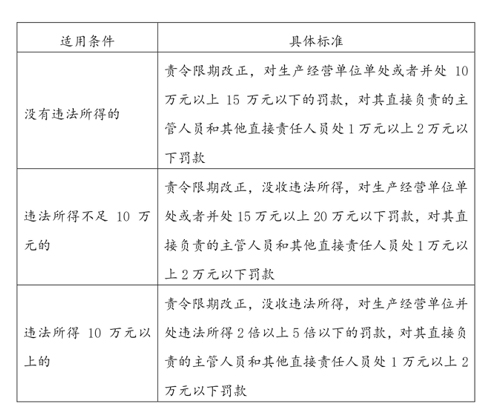
(2) Investment amount standard. For example, Article 98 of the Safety Production Law stipulates that discretion is based on the amount of investment, and the basis of discretion is:
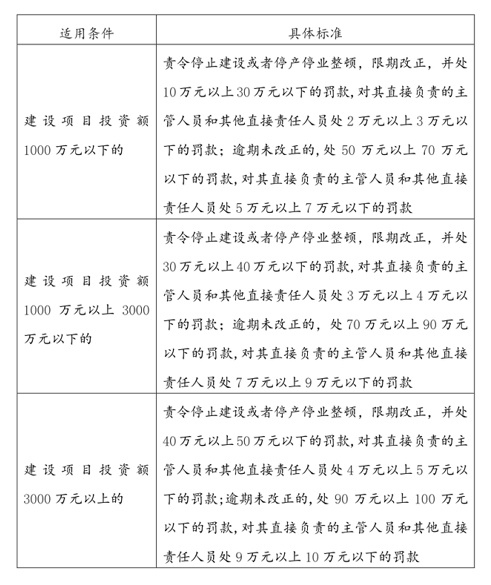
(3) Standard for the size of the number of employees in the employing unit. For example, Article 97 (7) of the Safety Production Law stipulates that discretion shall be based on the size of the number of people, and the basis of discretion is:

(4) Accident occurrence criteria. For example, Article 96 of the Safety Production Law stipulates that discretion shall be based on accidents, and the basis of discretion is:
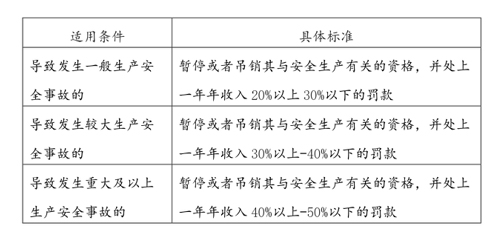
(5) During the duration of the illegal act. For example, Article 77 (2) of the Regulations on the Safety Management of Hazardous Chemicals stipulates that discretion shall be based on the period during which the illegal act exists, and the basis of discretion is:

5、 Issues that need to be addressed
(1) About Style Structure
In 2010, the former State Administration of Work Safety issued a notice on the "Discretionary Standards for Administrative Penalties on Work Safety" (AJZZF [2010] No. 137), listing relevant laws and administrative regulations on work safety, and formulating discretionary implementation standards according to their respective provisions, each containing three elements: description of illegal acts, basis for punishment, and implementation standards. Although the Standard categorizes legal and regulatory documents by type, there may be inconsistencies between the provisions of the upper and lower laws, resulting in inconsistent legal application. This time, the "Benchmark" is formulated to break the existing framework model of dividing discretion standards based on the structure of legal documents. A total of 36 safety production laws, regulations, and rules with emergency management departments as the main law enforcement body are sorted and summarized, including 1 safety production law, 6 administrative regulations such as the "Regulations on Reporting and Investigation of Production Safety Accidents", and 29 departmental rules such as the "Measures for the Administration of Hazardous Chemical Business Licenses". On this basis, illegal activities will be classified and subdivided into comprehensive categories, administrative approval categories, education and training categories, technical services categories, hazardous chemicals categories, oil and gas extraction categories, fireworks and firecrackers categories, industrial and trade enterprises categories, emergency rescue categories, accident reporting and investigation and handling categories according to different types. For the same illegal activity that has been stipulated in multiple legal documents, it will be listed in the column of punishment basis, Convenient for administrative law enforcement personnel to quickly search and search, and conducive to more clear and sufficient application of relevant legal basis in the exercise of discretion.
(2) Regarding the basis of punishment
Currently, in the "Penalty Basis" column, if laws, administrative regulations, and departmental rules stipulate the same illegal act, they are listed in order of effectiveness level, but there may be inconsistencies between the provisions. At present, in the application of specific discretionary power standards, the following model is adopted to solve: priority is given to the application of laws with higher levels of effectiveness, those with the same level of effectiveness, those issued and implemented later have priority over those issued and implemented first, and special provisions have priority over general provisions for application. For example, Article 114 of the Safety Production Law and Article 37 of the Regulations on Reporting, Investigation and Handling of Production Safety Accidents both provide administrative penalties for production and business units that have experienced production safety accidents, but their provisions are inconsistent. In the current discretionary power benchmark, based on the principle of prioritizing the application of laws with higher levels of effectiveness, a discretionary power benchmark is set for the illegal act in accordance with the provisions of the Safety Production Law. In recent years, laws, administrative regulations, and departmental rules in the field of safety production, including the Safety Production Law, have been promulgated and revised one after another. However, there are still a considerable number of documents that have not been revised since their promulgation, and some penalty provisions have not been effectively connected with the Safety Production Law. At present, in the penalty basis column of the Discretionary Rules table, departmental rules and provisions that are inconsistent with the provisions of the upper law will not be listed, and only the provisions of the upper law and the new law will be retained to ensure that administrative law enforcement personnel strictly regulate law enforcement.





